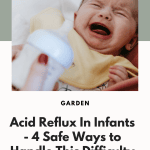Is your child constantly irritable and continuously spitting up? Do they shriek from pain when they are laying flat on their backs? These may be signs of a condition called gastroesophageal reflux (GER), and we’re here to reassure you that you’re not alone. Acid reflux in infants is a common stomach discomfort that many babies experience and we have some suggestions and tips to help suppress the tears – (yours, as well as your baby’s!)

What is Infant Reflux?
Acid reflux in infants in simple terms, is “heartburn.” It’s when the stomach contents move into the esophagus and/or mouth. In infants, that could be either milk or stomach acid. Around 25% of babies have some degree of gastroesophageal reflux (GER), ranging from mild (where they painlessly spit up numerous times daily) to severe (abdominal pain, waking at night, colic symptoms.) It’s now known that the diagnosis of “colic” in the past, can likely be pinpointed to GER. It’s estimated that between 40-60% of infants experience some form of reflux, so the correlation between the two may or may not be coincidental.
GER occurs when the lower band of muscle that is supposed to act as a one-way valve allowing food and liquid into the stomach is immature and not quite developed enough. This band of muscle is more relaxed, which allows for reflux back into the esophagus and possibly the mouth. The contents irritate the lining of your esophagus, and that is what we, as adults, label “heartburn.”
We also know that there are two types of GER associated with infants: gastroesophageal reflux, and laryngopharyngeal reflux, also known as “silent reflux.” Silent acid reflux in infants occurs when the baby is able to swallow the contents back down, but not before the contents irritate the esophagus. This type can be much more difficult to diagnose because it won’t be as obvious as having been spit up on hundreds of times throughout the day. It is possible for a child to suffer from both types simultaneously.


What are the Symptoms of GER and Silent Reflux?
Infants who suffer from silent acid reflux in infants may have some or all of the symptoms, while infants with GER will spit up and exert some or all of the following symptoms:
- Sour breath and wet-sounding burps
- Sudden bouts of intense crying
- Trouble breathing or asthma-like symptoms, or pneumonia
- Baby pauses while breathing (apnea), or breathes noisily
- Difficulty feeding
- Frequent hiccups
- Spitting up or vomiting
- Inhaling food
- Hoarse voice
- Difficulty gaining weight
- Coughing
- Gagging or trouble swallowing
- Irritability, particularly after feedings
- Arching of the back—often during or immediately after feedings
- Poor feeding or refusal to feed
- Cries when positioned flat on their back
- Colic
READ MORE: ABC’s of Safe Sleep for Infants
Now What?
All is not lost! Keep in mind that acid reflux in infants is an actual medical condition, and options for treatments should be discussed with a board-certified pediatrician. They may suggest placing them on a prescriptive medication, or starting a different regimen to help suppress the symptoms as much as possible. A huge culprit of acid reflux in infants is their diet. If you are exclusively breastfeeding, that in turn, means your diet. Breast milk has a huge advantage over formula for babies with reflux because it contains enzymes to speed digestion.
Additionally, a baby cannot be allergic to its mother’s milk itself, compared to a specific type or ingredient in formula. A baby can be sensitive to something the mother is ingesting, however, and the most common culprit is dairy. In many cases, eliminating dairy from the mother’s diet can calm the symptoms of acid reflux in infants, but it’s important to note that it can take upwards to two weeks for all traces of dairy to leave your body. If you are formula feeding, use a hypoallergenic variety of formula recommended by your doctor. (And check out this post on What’s In Your Baby’s Formula?)
READ MORE: Choosing the Best Formula for Your Infant
Once you begin evaluating what your baby is eating, it’s time to change how your baby eats to help prevent acid reflux in infants.
- Offer smaller feedings more frequently. Avoid over-stuffing your baby, or allowing them to space out their feeding sessions, and binge when the time comes. When smaller amounts of milk are in the stomach, digestion is easier and quicker.
- Adjust how you are feeding them. Is your baby gagging during your first forceful letdown? Try pumping before offering them the breast, to eliminate that first flow of milk that could be gagging them, and causing them to choke. You can either choose to store the milk by freezing it for later or offer it to your baby at the end of the nursing session in a bottle designed to reduce colic such as these Tommee Tippee Anti-Colic Bottles.
- Changing the position in which you feed your child is also important, and feeding them at an inclined angle may help reduce reflux, and will help aid digestion.
- Keep your baby upright and still after a feeding. Let gravity do its part by keeping the baby in an upright position for at least 30 minutes after they eat. When they are flat on their back, it will be harder for the muscular band to remain shut, and more spitting up and discomfort will occur. Dr. Sears suggests sitting with your baby in your lap, with their head nuzzled against your chest (or using a wrap or sling that will place them in this position such as a Skin to Skin shirt, or Moby Wrap featured below.)
- Let them sleep comfortably. Finding out your infant’s preferred sleep location, position, or angle is kind of a game of trial and error, in many cases. Does your baby sleep well in their swing? By all means, let them sleep in their swing. Now is not the time to worry about what inclined sleeping may be setting you up for weaning them from it in the future. Most babies outgrow GER by the time they are 6-9 months, so you can rest assured that you won’t have to worry about being tasked to build an adult-sized swing for them to take with them to college to sleep in.


Products That Can Help Acid Reflux in Infants
Sleeping:
Sometimes, all that babies with reflux need is a bit of motion to help them sleep, or stay asleep, whether that movement is through vibrations, rocking, or swaying. If your baby prefers a rocking motion, we adore the Hushamok Baby Hammock, which is a great alternative to a bassinet. Made with 100% organic materials, the Baby Hammock is soft, snuggly and has movement designed to mimic the womb. Stay tuned for a full feature on this awesome product and all it has to offer, coming soon!
READ MORE: Why You Should Buy A Two-Stage Crib Mattress For Toddlers and Infants
As mentioned above, sleeping at a slight incline may help your baby to be more comfortable and have a better rest period. There are a bunch of different options available on the market that will keep your baby at an incline for sleep, such as the Kolcraft Cuddle N’ Care 2-in-1 Bassinet and Incline Sleeper, the Tiny Love 3 in 1 Rocker Napper, Acid Reflux Pillow Wedge, or a Rock-N-Play Sleeper.
Each item has its benefits and use, and finding your baby’s preference is (unfortunately) many times a game of trial and error. Do not discredit something because it didn’t magically allow you hours of uninterrupted sleep the very first night though. It’s a learning curve, and what may not work one night may turn out to be their preferred method or angle of sleep after a while.
Eating:
As mentioned above, nursing or bottle feeding your baby who has acid reflux in infants, keeping their body at an inclined position has been found to speed digestion and decrease acid reflux in infants. We love Dr. Brown’s Gia Angled Breastfeeding Pillow for that very reason. The pillow sits taller, and wider than most nursing pillows, giving mom (and baby) the versatility to choose which position, and/or angle works best for them.
The Gia was created by a lactation consultant and has a large surface area, preventing the baby from rolling, slipping, or being caught in the “crack” that many other pillows have. The pillow is 100% natural cotton, keeping it soft and comfortable, and you can use the Gia with or without a decorative (yet functional) cover.
Out And About:
Positioning your infant after feedings is also very important, as having a full belly is often the most painful time for acid reflux in infants. Keeping your baby in an upright position for at least 30 minutes generally helps, however, few mothers have the time to remain seated for such long periods of time. While you won’t want to jostle or do too much activity wearing your baby, using a wrap is a great option, and our favorite woven wrap to maintain this position is the Moby Wrap.
READ MORE: KeaBabies: The Best Diaper Bag with 3 Essential Items You’ll Need
The Moby Wrap uses the entire back and shoulders to distribute your baby’s weight, making it comfortable for both you and your little one. There are no straps or buckles to pinch, and the material is soft and breathable. It has a wide piece of fabric that will fit snugly over your baby’s shoulders, keeping them close to you and providing a very secure feeling. And with 20 color options, there is a Moby Wrap for every Mom and baby duo.
If using a wrap seems complicated, and your little one prefers to have skin-to-skin time, the Kangaroo Care shirt from Milk & Baby is the perfect choice. These shirts truly are 3-in-1; they are a carrier, a nursing top, and a postpartum shirt that supports your belly. The Kangaroo Cares shirts are a breeze to take on and off, and will help your newborn establish a healthy breastfeeding relationship, and will keep them secure during their fourth trimester.
The Kangaroo Care shirt fits babies up to 15 lbs and will hold them close to your heart, as well as in the ideal inclined position with their head on your chest. We love the Milk & Baby brand especially, because they offer skin-to-skin shirts in many different styles, as well as one specifically for plus size, and even for men! Keep your baby close to your heart with this easy-to-use shirt that is easy, and comfortable.
Whatever path you go down, or item you choose, know that acid reflux in infants is temporary and that you are not alone. Connect with other mothers who are dealing with the same issues you’re facing. Find a support group, online forum, or local meetups that can help you remain positive and empowered as you navigate these challenges. You’ll be surprised how common infant reflux is, and how many of your friends have “been there and done that.” In fact, their clothing may still sport the battle scar spit-up stains to prove it.
You can also talk with your doctor or a lactation consultant for helpful advice about acid reflux in infants. By understanding your baby’s needs, you’ll be able to make the best decisions for your family.
This post is meant for educational purposes only. It is not intended to replace medical advice from your physician, doctor or health care professional. Please read our terms of use for more information.
Sources: GERD and Acid Reflux in Infants and Children, Ask Dr. Sears: Coping With Baby’s Acid Reflux, Silent Reflux in Infants (Laryngopharyngeal Reflux),
Photo Credits: Becca P, The Memoirs of Megan, Kayla Grant Photography, Little Miss Eclectic Photography
CONNECT WITH DAILY MOM
💖 NEWSLETTER: DAILY READS IN YOUR INBOX 💖
Sign up to receive our picks for the best things to do, see and buy so you can relax and focus on more important tasks! Let us help you be the best version of yourself you can be!
BE SOCIAL WITH US
📌 LOVE IT? PIN IT!📌








































